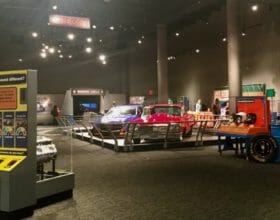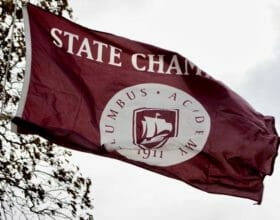In little more than 15 years, the computer science program at Academy has grown from its humble beginnings into a resounding success. A lot of changes have been made to the curriculum. For starters, there wasn’t even a comp. sci. lab. “We were only scheduled to go to the computer lab one out of every five days, and it was taught in what is currently Mrs. Murray’s room,” remarks Mr. Daubenmier, who founded the AP Computer Science program at Academy in 1995.
Soon afterwards, a new computer lab was built for the course, and Mr. Daubenmier has been master of the “ones” and “zeroes” ever since. One of the guiding principles of the course is “lots of hands-on time,” where the students can spend time applying the skills they learn, not just learning them. “Everyday I want the students writing code. I want students not only to master the content, but also to hone their critical thinking and problem-solving skills,” says Daubenmier.
 Many people have taken notice of the computer lab’s new look, but the old lab was not at all a bad design. Little was left to chance, and even small details were considered in the previous arrangement. “The design of the room previously was intentional, because as you know, in the Buckeye State, it was in the horseshoe shape,” says Daubenmier, “So when students were working, I could see all monitors simultaneously without using special software. It definitely makes it a lot easier to make sure everyone is on task and to identify if a student needs help.”
Many people have taken notice of the computer lab’s new look, but the old lab was not at all a bad design. Little was left to chance, and even small details were considered in the previous arrangement. “The design of the room previously was intentional, because as you know, in the Buckeye State, it was in the horseshoe shape,” says Daubenmier, “So when students were working, I could see all monitors simultaneously without using special software. It definitely makes it a lot easier to make sure everyone is on task and to identify if a student needs help.”
From a functionality standpoint, there was nothing wrong with the room. So what gives? Why mess with something if it’s not broken? “There’s lot of great programmers in the world,” says Daubenmier, “And our students are going to be entering a global marketplace, and when you think about all the countries in the world, be it India or China, or wherever else, they’re also turning out great programmers. So it’s not enough to simply be a great programmer.”
One of the big ideas in education circles is the inclusion of collaboration and communication, the ability to work well with others to achieve a common goal. Daubenmier says, “I felt that I needed to take the course to the next level where I could really get after those things as well. I had done some collaborative things in the past, but it was somewhat lame. It was two students sitting side by side, each with a laptop, semi-collaborating. It did not go all that well. I became convinced that if I could change the paradigm of the room, so that it more naturally facilitated that collaborative piece, then students would walk in and be like, ‘Oh. This is different.’”
Now the room is composed of a number of “programming pods,” each with a wall-mounted monitor that can be connected to a laptop. “It now naturally invites conversation around a single monitor,” says Daubenmier. Around each monitor is a small group, with a single laptop. One person at a time is physically typing code, which shows up on the monitor, and the other members of the group can comment on what they see. And the conversation becomes more focused on the task at hand. It also helps that students are helping each other, providing more immediate feedback, even if the instructor isn’t available. Another big piece is about getting students to communicate with each other. You can’t be “grabbing the laptop to show them how to do it. You have to explain it with your words in a polite and cordial way,” stresses Mr. Daubenmier. Programming is now more about working together and collaborating than just writing code.
While this has been a somewhat gradual change in mindset and philosophy, Mr. Daubenmier also admits he had an “epiphany moment” during this process. As he recalls, “A little over a year ago, I went down to the airport and picked up a young lady who was coming from China; she had just graduated from an independent school and was coming to America to go to college. She stayed with our family for a few days so she could get settled in, and since she had graduated from an independent school, and I teach at an independent school, it was just a natural time to compare notes about what school was like for her versus what school is like for students here at Academy. And here at Academy, students take a year of bio, chem., and physics, and maybe an elective their senior year. She took bio, chem, and physics every year, so she had three sciences a year. Here at Academy, we typically do the algebraic track for math, algebra, pre-calc, calc, and some students take stats. She took two math courses every year, one algebraic and one stats, for three years in a row. As we went through comparing notes, I realized her school day was much longer than Academy’s, and in terms of contact minutes, each day she went to school was equivalent to two Academy days, and she went to school six days a week, and she had a two week summer break.”
“It just reminded me afresh that being technically proficient, being a great programmer, isn’t enough, because the world is full of great programmers.” While being a good programmer and doing well on the AP are still very important, they’re no longer enough in today’s competitive world. It’s more about your people skills. Can you work together with others and communicate your ideas clearly to them? For Mr. Daubenmier, that was the fundamental reason for changing his room and altering how his class operates.
So far, the new system has been working well. “I’ve been giving the same tests I gave last year, and we’re working through the material at the same rate as last year. The room is working out better than I expected. I thought I’d have to do more to get students to embrace collaborating together, and I have been pleasantly surprised at every turn. While we won’t necessarily know how well this works out until the AP, I think it’s going very well.”
No effort of this magnitude gets achieved without collaboration, and a lot of people put effort into making the new computer lab a reality. Mr. Daubenmier is quick to point out that, “This isn’t just me doing something to my classroom. There were a lot of other people that got involved in this. PACA helped provide some the funding for the room. Doug Bennett and his crew made a huge commitment to the room. I had designs for tables I wanted, but we couldn’t find them commercially. So Doug, Bob Hughes, and his crew built them from scratch. Mr. Cullinan and the tech team helped me swap my desktops for a laptop cart, since they work much better with the current setup. So really, a lot of people joined with me to help make it possible.” The very process of creating the new computer lab is a perfect example of what Mr. Daubenmier hopes to teach his students: the importance of collaboration and working together to achieve a common goal.
Written by Andy Li’13. Photos by Jeremy Schroeder’14.








